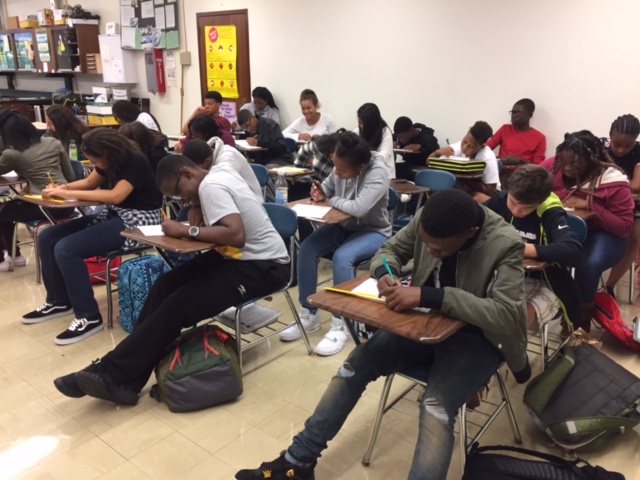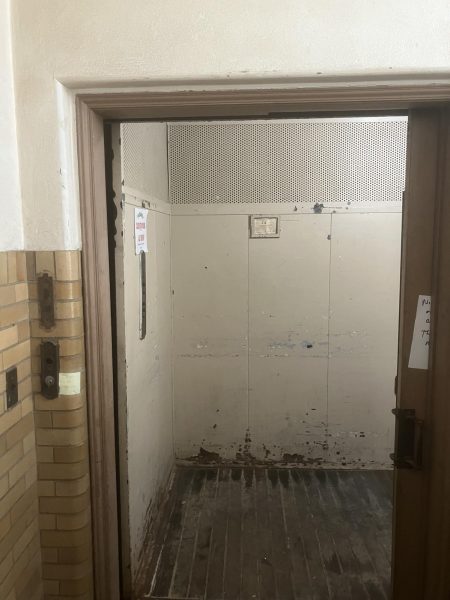District Evaluations Committee Eradicates SLO from Shaker Schools
Teacher evaluations, which used to be derived from the SLOs, will now depend on MAP testing for a base grade
Geoffrey Gainford’s ninth period physical science takes a test at the beginning of the year.
The District Evaluations Committee decided to eliminate the SLO test from its role in teacher evaluations with a school-wide grade based on eighth grade MAP tests.
The SLO test, or the Student Learning Objective, is not used for tracking students’ learning, but, rather, the effectiveness of the teachers’ lessons. It was implemented statewide in Ohio in 2014.
With the SLO, 50 percent of teachers’ evaluations were based on student improvement, measured using scores from the beginning of the year and the end of the year.
The SLO test did not bode well with Shaker faculty, students or parents.
Senior Dajuan Herring summarized his strong feelings of contempt for the SLO. “I hate the SLO test because it’s just slow.”
Senior Luke Zagara thinks that the SLO test was pointless. “You don’t fatten a pig by weighing it,” he said.
Latin teacher Nora Murphy said the SLO test did not have any effect on her curriculum. “It really didn’t help the running of the classroom; I didn’t change how my class was taught based on the initial SLO evaluations. It was just one more test,” she said.
The District Evaluations Committee sent out an email to the Shaker Heights District. “Over the past few years, Shaker Heights has become a leader across the state in advocating for the reduction of the over-testing of our students,” it stated. It continued, stating that instead of considering the SLO as a factor of teacher evaluation, the District Evaluations Committee would administer a school-wide shared attribution score.
“This change will eliminate the need to administer Student Learning Objectives (SLOs) as a measure of educator effectiveness at all grade levels and will ensure that we continue to support literacy instruction and skill development across all content areas.”
Data from the MAP test, regarding student improvement, will replace the data for the SLO. “For the 2017-2018 school year, the shared attribution student growth metric will be based on 8th-grade MAP reading scores,” the email stated. Middle school Principal David Glasner assures the accuracy of this assessment. “It is at least as accurate as what we’ve used in the past, and will certainly be much more effective in terms of real opportunities and authentic opportunities for students to be engaged in learning throughout the year and for teachers to administer authentic assessments,” he said.
What is the MAP test? The test website boasts about its success rate among students and its method. MAP Growth tests are online tests that give appropriate grade-level questions and progress in difficulty in accordance with the student’s accuracy.
Principal Jonathan Kuenhle explained the main contrast between the MAP test and the SLO test: The MAP test will not be used as part of a teacher evaluation. Shaker Heights now uses a system of shared-attribution — 50 percent of the teachers’ scores are a base score given to the whole school.
Murphy explained the meaning of it. “The score that we would have gotten from the 50 percent is made up by a building-wide number that every teacher receives … It doesn’t matter because our individual evaluations will then distinguish us from the other teachers, in a sense,” she said.
Math teacher Walter Slovikovski is confident in the district’s decision. “I mean, I’m trusting that people above me are making good choices,” he said.
Principal Jonathan Kuenhle said the main reason for the decision was that many teachers felt there was a better way to assess students and maximize instruction time.
Senior Brian Ford feels that the MAP test will be more accurate in charting student growth. “I feel like it gives the teachers a fairer shot because I know some people during the SLO test probably wouldn’t give much of an effort. So, I feel like this is maybe more of a way for teachers to not depend as much on students and be able to be assessed more on what they’re teaching,” he said.
Murphy summed up her feelings on the testing change. “I think it will be interesting to see how this actually pans out; they have to use something,” she said.






